Framework for Cement Plants Assessment Through Cement Production Improvement Measures for Reduction of CO2 Emissions Towards Net Zero Emissions
Abstract
1. Introduction
1.1. Study Aim
1.2. Theoretical Concept Behind Model Development
2. Materials and Methods
2.1. Methodological Framework and Structure
- Purpose: it focuses on assessing decarbonization measures for cement plants to achieve NZEs by 2050, while other systems evaluate sustainability performance.
- Scope and assessment criteria: It covers improvement measures related to CO2 emissions reduction, energy efficiency, alternative fuels and raw materials, technology innovations, product improvements, and facility operations efficiency. On the other hand, the rating systems cover broad ESG factors.
- Targeting: it is designed for cement plant decision-making and for operators to evaluate the performance of the plant, whereas companies across the industry use the rating system.
- Certification: It offers scores for each improvement measure based on an evaluation key, with action plans and detailed results reporting to improve the plants’ performance across different improvement measures. Rating systems provide sustainability ratings of silver, gold, platinum, or bronze based on environmental performance.
- Methodology: it uses quantitative and qualitative models with the needed KPIs and global targets as references to track the plant’s progress towards NZEs and is not based on questionnaires only.
- Focus on carbon emissions: it focuses primarily on carbon emissions reduction in cement production facilities by evaluating CO2 emissions improvement measures, while the other rating systems include carbon emissions as one of many environmental criteria and do not specialize in cement-specific decarbonization strategies.
- Benchmarking: it allows cement plants to compare the various CO2 emission reduction measures against global best practices and NZE targets. However, the other evaluation methods allow companies to compare their performance against industry peers.
- Action plans: it offers technical insights tailored to specific cement plants to achieve the NZE targets based on scores, bar charts, and historical data logging across the supply chain in the cement industry.
2.2. Data Collection and Classification
2.3. Process Mapping and Data Normalization
- Yes means the emissions and energy consumption of each step of production are reported as planned;
- No means emissions are generated, and the energy consumption of each step of production is not reported as planned. This should be explained in the comments cell;
- N/A means emissions are not generated or this step or does not exist at this plant.
2.4. Identifying and Evaluating Key Improvement Measures
- Accessibility: Accessing comprehensive and up-to-date data with respect to the study objective, especially in international cement plants;
- Reliability: The accuracy of the data is subject to the source’s creditability;
- Completeness: The parameters of systematic collection and reporting affect the depth of the analysis. Incomplete datasets could affect the results;
- Confidentiality: Some data may be sensitive, with limited access and agreements needed for data provision. This could restrict the analysis of certain parameters;
- Identification of key environmental performance indicators, including CO2 emission intensity, waste management, resource utilization, and energy efficiency for reduction potential.
- Energy consumption from clinker and cement production;
- Process efficiency of each stage of cement production, waste generation, and water consumption;
- Avoiding CO2 emissions by replacing or incorporating CO2 emissions;
- Fuel from the calcination process.
2.5. Develop a Scoring System and Calculations
2.6. Interpreting the Results and Overall Rating Scores
2.7. Sensitivity Assessment
2.8. Site Constraints and Applicability
2.9. CO2 Emissions Calculations
3. Results
3.1. Industry Evaluation of Improvement Measures
3.2. Analysis of the Proposed Improvement Measures in Two Case Studies (Plants A and B)
- Alternative fuels (AF): Both plants are incorporating alternative fuels such as RDF, TDF, used oil, and biomass to reduce reliance on fossil fuels. For instance, the use of substitutional fuels in plant A was 13.1% in 2022 and 19.5% in 2023. In addition, alternative fuel utilization was recorded at 33.17%. Cement plant A has achieved a thermal substitution rate (TSR%) exceeding 30%. This is an indication of the percentage of thermal energy derived from alternative fuels that reflects the cement plant’s environmental performance and reliance on non-conventional fuels. The increased use of alternative fuels reduces CO2 emissions [38]. In 2023, cement plant A made significant efforts in improving its sustainability initiatives by safely utilizing RDF. This milestone helps to significantly reduce CO2 emissions by promoting co-processing.
- Energy Efficiency (EE) and Kiln technology upgrade (EK): Energy efficiency is a key factor in the decarbonization plans of both plants. In 2023, the consumption of thermal energy and electrical energy by plant A were 9756 TJ and 1235 TJ, respectively.
- Upgrading kiln technology by modernizing kiln operations to optimize thermal energy consumption. This was performed by upgrading their preheater and calciner systems. Also, plant B is working on a novel kiln technology that will be able to capture more than 500,000 tons of CO2 emissions by 2025.
- Waste heat recovery systems are implemented in some facilities to capture and reuse heat generated from kiln and clinker production, which helps in electricity generation and supplies energy for other processes, reducing overall energy consumption and, hence, the CO2 emissions of the plants.
- Clinker-to-cement ratio is optimized using additives such as fly ash and slag in the cement production process. This leads to a significant reduction in CO2 emissions.
- The use of modern, efficient grinding mills has contributed to the reduction in electricity consumption and led to the reduction in CO2 emissions. Vertical roller mills are more energy-efficient than traditional ball mills.
- Cement plants A and B are ISO certified with ISO 50001, the energy management system certification [39]. In addition, plant A has invested 97% of its resource allocations in environmental strategies, where 27% are invested in environmental management, and 70% are invested in environmental technologies, for example, as shown in Figure 6.
- Renewable Energy (AR): Plant A has initiated a major solar power project that will help reduce electricity consumption, contributing to a reduction in CO2 emissions. In addition, the use of renewable energy has risen to 11.4%.
- CO2 and heat control (IC) and Innovative technology and integration (II): Both plants are committed to the COP21 Paris Agreement goals. In 2022, the CO2 emissions per ton of cement for plant A had reduced to 679 kg/ton of cementitious product. In addition, in 2023, scope 1 emissions had reduced to 648 kg/ton of cementitious product, while scope 2 emissions remained at 0.16 million tons.
- Change in Raw Material and Product Development (RA, RP, and RC): Both plants produce advanced low-carbon cement, which is designed to be more environmentally friendly. It also has lower clinker content, which produces lower CO2 emissions compared with ordinary cement (CEM I). The percentage of low-carbon green products under development in cement plant A reached 13% in 2023, as presented in Figure 7. Cement plant B produces low-carbon cement with 30% lower CO2 emissions than CEM I, which translates into 30% low-carbon concrete.
3.3. Assessment Tool Scores for Both Plants
4. Discussion
- Potential variability: both plants implemented several of the evaluated CO2 improvement measures, but their overall performance scores differed due to the implementation level of each measure and its impact on the sustainability of the plant and the reduction in CO2 emissions.
- Future improvements: The model provides a cohesive mapping of the level of implementation of CO2 improvement measures across the cement value chain based on the materials and energy flow. By continuously applying the assessment tool, plants can track their progress over time and adjust strategies and resource allocation. The model revealed that even well-established cement plants have opportunities for improvement and further efficiency.
- NZE goal alignment: The model is aligned with the NZEs goal for 2050 and the intermediate milestones for 2030 and 2040, and the tool takes these targets into account during the calculation and evaluation of emissions. The results confirm that achieving NZEs in the cement industry is challenging and requires the integration of technological, operational, and regulatory solutions.
5. Conclusions
Author Contributions
Funding
Data Availability Statement
Conflicts of Interest
References
- Harraz, H.Z.; Hamdy, M.M.; Abu El-Ela, A.S.M.; El-Hoseiny, I.M. Assessment of Raw Materials for Cement Industry In El Sukhuna-Zaafrana Area, Eastern Desert, Egypt. Delta J. Sci. 2020, 42, 108–124. [Google Scholar] [CrossRef]
- Hamza, A.S. Assessment of Carbon Dioxide Emission and Its Impact on High-Rise Mixed-Use Buildings in Egypt. Master’s Thesis, The American University in Cairo, AUC Knowledge Fountain, Cairo, Egypt, 2021. [Google Scholar]
- IEA. Net Zero by 2050: A Roadmap for the Global Energy Sector; The International Energy Agency: Paris, France, 2021. [Google Scholar]
- CEMBUREAU. Cementing the European Green Deal: The 5Cs, Reaching Climate Neutrality Along the Cement and Concrete Value Chain By 2050; The European Cement Association: Brussels, Belgium, 2020. [Google Scholar]
- IPCC. Global Warming of 1.5 °C: An IPCC Special Report on the Impacts of Global Warming of 1.5 °C Above Pre-Industrial Levels and Related Global Greenhouse Gas Emission Pathways, in the Context of Strengthening the Global Response to the Threat of Climate Change, Sustainable Development, and Efforts to Eradicate Poverty; Cambridge University Press: Cambridge, UK, 2022. [Google Scholar]
- GCCA. Cement Industry Net-Zero Tracker; World Economy Forum: Geneve, Switzerland, 2023. [Google Scholar]
- IPCC. Climate Change 2022: Mitigation of Climate Change; Intergovernmental Panel on Climate Change: Geneva, Switzerland, 2022. [Google Scholar]
- UNFCCC. UNFCCC Secretariat Recognition and Accountability Framework Draft Implementation Plan with Respect to Net-Zero Pledges of Non-State Actors and Integrity Matters; United Nations Framework Convention on Climate Change: New York, NY, USA, 2023. [Google Scholar]
- USGCRP. The U.S. Global Change Research Program 2022–2031 Strategic Plan; United States Global Change Research Program: Washington, DC, USA, 2022.
- Khalil, E.A.; Abouzeid, M.N. Computation of the environmental performance of ready- mix concrete for reducing CO2 emissions: A case study in Egypt. J. Elsevier Energy Rep. 2023, 9, 144–148. [Google Scholar] [CrossRef]
- Adesina, A. Recent advances in the concrete industry to reduce its carbon dioxide emissions. J. Elsevier Environ. Chall. 2020, 1, 100004. [Google Scholar] [CrossRef]
- Fayomi, G.U.; Mini, S.E.; Fayomi, O.S.I.; Ayoola, A.A. Perspectives on environmental CO2 emission and energy factor in Cement Industry. IOP Conf. Ser. Earth Environ. Sci. 2019, 331, 012035. [Google Scholar]
- USGS. Cement Production Statistics and Information: Statistics and Information on the Worldwide Supply of, Demand for, and Flow of the Mineral Commodity Cement; National Minerals Information Center: Denver, CO, USA, 2023.
- Luo, J.; Hunang, R.; Wang, J.; Zhang, Y. Carbon Sequestration by Preparing Recycled Cement, Recycled Aggregates, and Recycled Concrete from Construction and Demolition (C&D) Wastes. Materials 2024, 17, 5020. [Google Scholar] [CrossRef]
- Mokhtar, A.; Nasooti, M. A decision support tool for cement industry to select energy efficiency measures. Energy Strategy Rev. 2020, 28, 100458. [Google Scholar] [CrossRef]
- Kusuma, R.T.; Hiremath, R.B.; Rajesh, P.; Kumar, B.; Renukappa, S. Sustainable transition towards biomass-based cement industry: A review. Renew. Sustain. Energy Rev. 2022, 163, 112503. [Google Scholar] [CrossRef]
- Fadayini, O.M.; Madu, C.; Oshin, T.T.; Obisanya, A.A.; Ajiboye, G.O.; Ipaye, T.O.; Rabiu, T.O.; Akintola, J.T.; Ajayi, S.J.; Kingsley, N.A. Energy and Economic Comparison of Different Fuels in Cement Production; IntechOpen: Rijeka, Croatia, 2021. [Google Scholar]
- IEA. World Energy Outlook 2022; Report by the International Energy Agency; IEA: Indianapolis, IN, USA, 2022. [Google Scholar]
- IEA. Global Thermal Energy Intensity from Cement Production; Report by The International Energy Agency; IEA: Indianapolis, IN, USA, 2023. [Google Scholar]
- Carbone, C.; Ferrario, D.; Lanzini, A.; Stendardo, S.; Agostini, A. Evaluating the Carbon Footprint of Cement Plants Integrated with the Calcium Looping CO2 Capture Process. Front. Sustain. 2022, 3, 809231. [Google Scholar] [CrossRef]
- IPCC. AR6 Synthesis Report: Climate Change 2023; Dadi, D.K., Zhai, P., Eds.; Intergovernmental Panel on Climate Change: Geneva, Switzerland, 2023. [Google Scholar]
- Elghamrawi, S. Greening the Cement Industry in Egypt: Exploring Decarbonisation Policies for the Cement Industry. Master’s Thesis, The American University in Cairo, AUC Knowledge Fountain, Cairo, Egypt, 2023. [Google Scholar]
- Costa, F.N.; Ribeiro, D.V. Reduction in CO2 emissions during production of cement, with partial replacement of traditional raw materials by civil construction waste (CCW). J. Clean. Prod. 2020, 276, 123302. [Google Scholar] [CrossRef]
- Khalil, E.A.; Abouzeid, M.N. Environmental Impact of Cement Plants in Egypt: A Comprehensive Study on Carbon Dioxide Mitigation Measures and Evaluation. In Proceedings of the Canadian Society for Civil Engineering (CSCE), Niagara Falls, ON, Canada, 5–8 June 2024. [Google Scholar]
- WBCSD. Vision 2050: Time to Transform; World Business Council for Sustainable Development: Geneva, Switzerland, 2021; Available online: https://archive.wbcsd.org/Overview/About-us/Vision-2050-Time-to-Transform/Resources/Time-to-Transform (accessed on 4 February 2025).
- Sayad, T.; Moursy, F.I.; El-Tantawi, A.M.; Saad, M.; Morsy, M. Assessment the impact of different fuels used in cement industry on pollutant emissions and ambient air quality: A case study in Egypt. J. Environ. Health Sci. Eng. 2023, 21, 107–121. [Google Scholar] [CrossRef]
- Vasileiadou, A.; Zoras, S.; Iordanidis, A. Fuel Quality Index and Fuel Quality Label: Two versatile tools for the objective evaluation of biomass/wastes with application in sustainable energy practices. Environ. Technol. Innov. 2021, 23, 101739. [Google Scholar] [CrossRef]
- Rocha, S.; Candia, O.; Valdebenito, F.; Flavio Espinoza-Monje, J.; Azócar, L. Biomass quality index: Searching for suitable biomass as an energy source in Chile. Fuel 2020, 264, 116820. [Google Scholar] [CrossRef]
- Khalil, E.A. A Global Assessment Tool for Reduction of CO2 Emissions Associated with Portland Cement and Relevant Sectors. Ph.D. Thesis, The American University in Cairo, AUC Knowledge Fountain, Cairo, Egypt, 2025. [Google Scholar]
- CEMBUREAU. Cementing the European Green Deal: Reaching Climate Neutrality Along the Cement and Concrete Value Chain by 2050. 2020. Available online: https://www.scribd.com/document/478753604/2020-Cementing-the-European-Green-Deal (accessed on 17 November 2024).
- El Haggar, S.M. Rural and Developing Country Solutions. In Environmental Solutions, 13th ed.; Elsevier: Amsterdam, The Netherlands, 2005; Volume 13, pp. 313–400. [Google Scholar]
- Yesilyurt, M.; Kocadagistan, B. Carbon Footprint Evaluation of a Ready-Mixed Concrete Plant. Nanoera 2023, 3, 8–15. [Google Scholar] [CrossRef]
- Breath. ESG in the Cement and Concrete Industry; Breathe Foundation: St. Louis, MO, USA, 2023. [Google Scholar]
- IPCC. Guidelines for National Greenhouse Gas Inventories. Agriculture, Forestry, and Other Land Use. The Intergovernmental Panel on Climate Change. Available online: https://www.ipcc.ch/report/2019-refinement-to-the-2006-ipcc-guidelines-for-national-greenhouse-gas-inventories/ (accessed on 20 November 2024).
- Nie, S.; Zhou, J.; Yang, F.; Lan, M.; Li, J.; Chen, Z.; Xu, M.; Li, H. Analysis of theoretical carbon dioxide emissions from cement production: Methodology and application. J. Clean. Prod. 2022, 334, 130270. [Google Scholar] [CrossRef]
- IPCC. Updates Methodology for for National Greenhouse Gas Inventories. The Intergovernmental Panel on Climate Change. Available online: https://www.ipcc.ch/2019/05/13/ipcc-2019-refinement/ (accessed on 25 January 2025).
- Gibbs, M.; Soyka, P.; Conneely, D. CO2 Emissions from Cement Production. The Intergovernmental Panel on Climate Change. Available online: https://www.ipcc-nggip.iges.or.jp/public/gp/bgp/3_1_Cement_Production (accessed on 14 October 2024).
- Vasileiadou, A. Reduction of CO2 emissions through the co-combustion of lignite with biomass residues: Renewable and non-renewable CO2 per produced megajoule and fuel characterization. Therm. Sci. Eng. Prog. 2024, 50, 102566. [Google Scholar] [CrossRef]
- ISO. International Organization for Standards in Energy Management. International Organization for Standards. Available online: https://www.iso.org/iso-50001-energy-management.html (accessed on 11 February 2025).
- Variny, M.; Varga, A.; Rimár, M.; Janošovský, J.; Kizek, J.; Lukáč, L.; Jablonský, G.; Mierka, O. Advances in biomass co-combustion with fossil fuels in the European context: A review. Processes 2021, 9, 100. [Google Scholar] [CrossRef]
- Saradar, A.; Rexakhani, Y.; Rahmati, K.; Majd, F.; Moein, M.; Karakouzian, M. Investigating the properties and microstructure of high-performance cement composites with nano-silica, silica fume, and ultra-fine TiO2. J. Innov. Infrastruct. Solut. 2024, 9, 84. [Google Scholar] [CrossRef]
- Plaza, M.G.; Martínez, S.; Rubiera, F. CO2 capture, use, and storage in the cement industry: State of the art and expectations. Energies 2020, 13, 5692. [Google Scholar] [CrossRef]
- Tkachenko, N.; Tang, K.; Mccarten, M.; Reece, S.; Kampmann, D.; Hickey, C.; Bayaraa, M.; Foster, P.; Layman, C.; Rossi, C.; et al. Global database of cement production assets and upstream suppliers. Sci. Data 2023, 10, 696. [Google Scholar] [CrossRef] [PubMed]
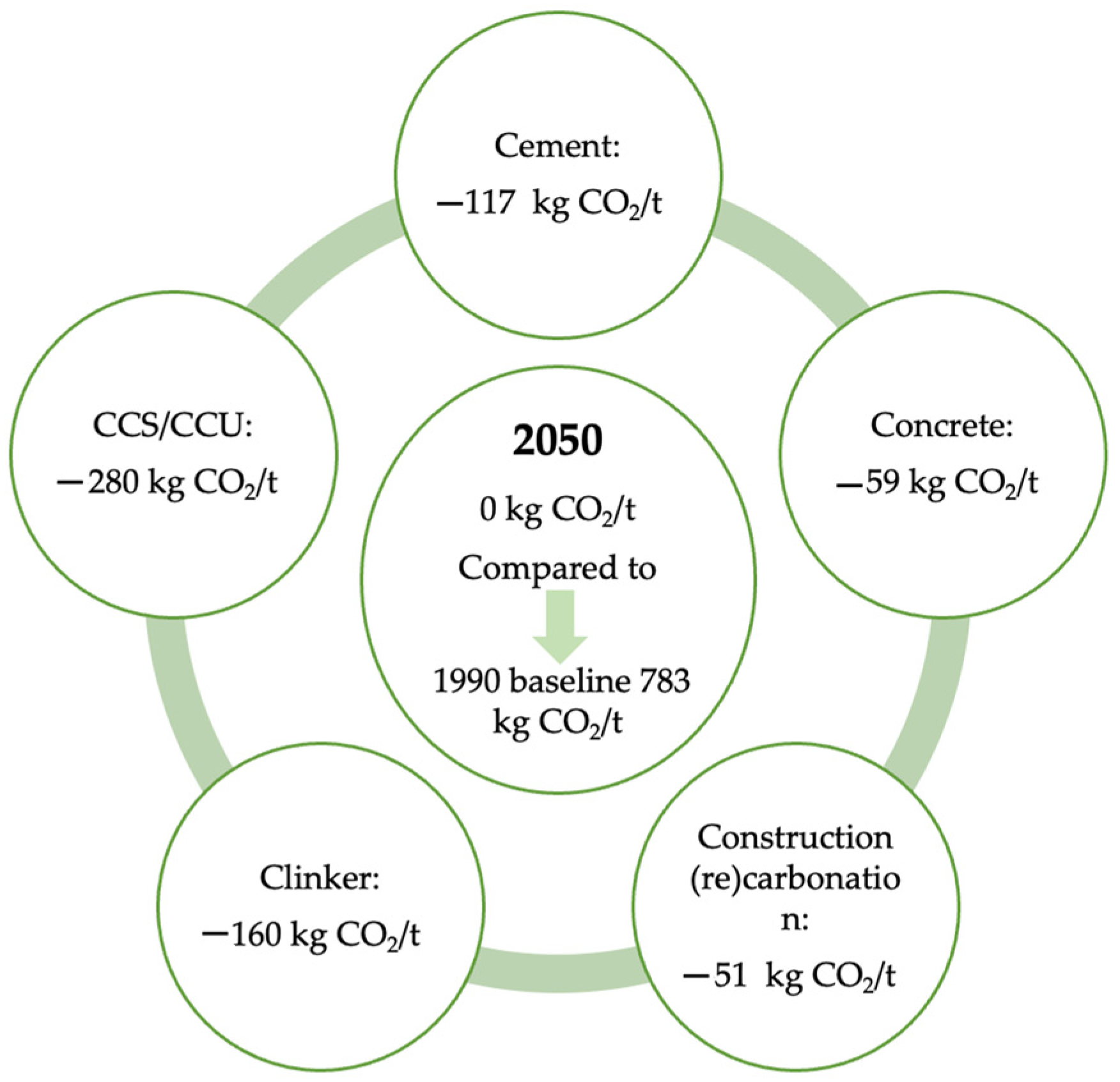
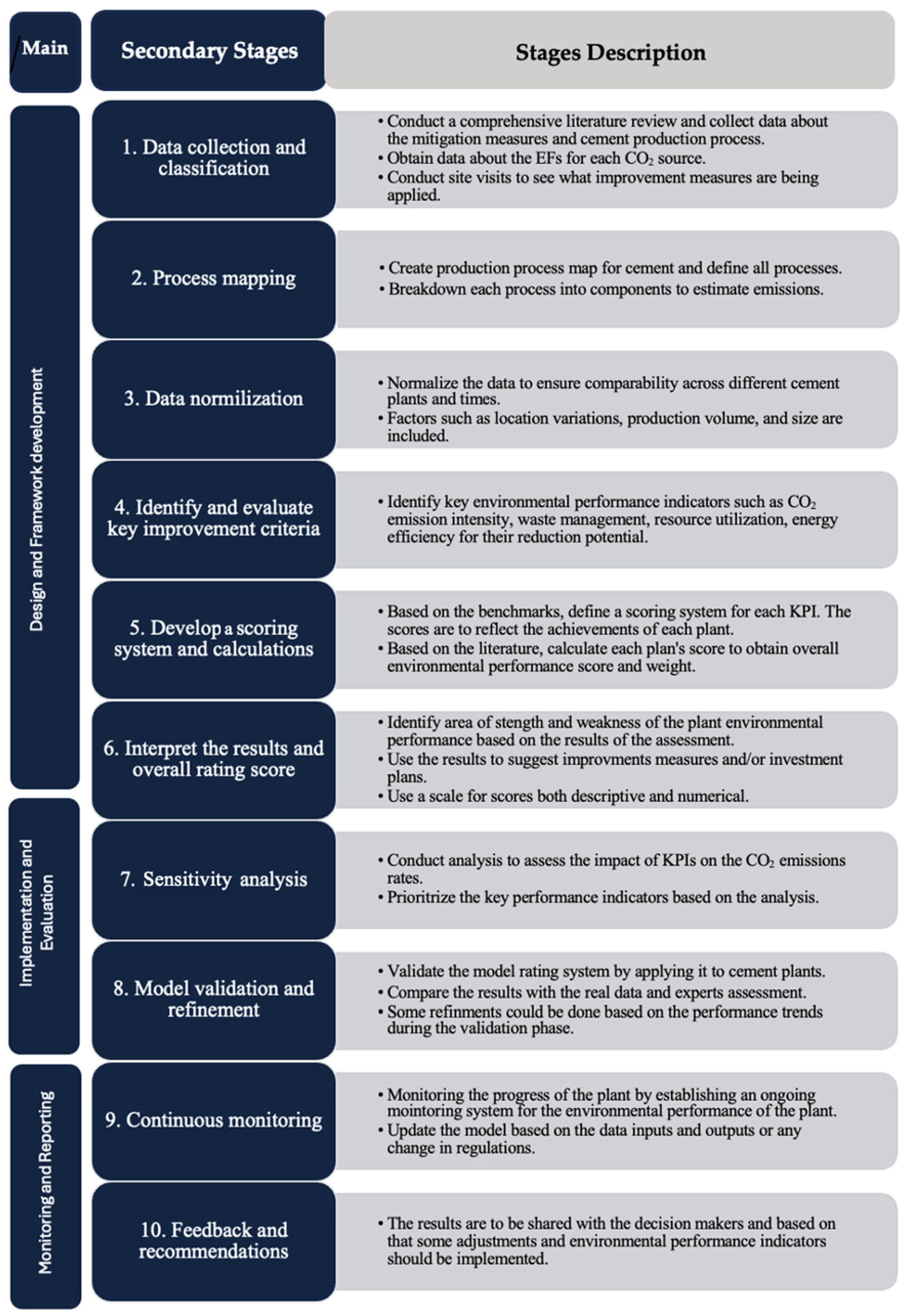
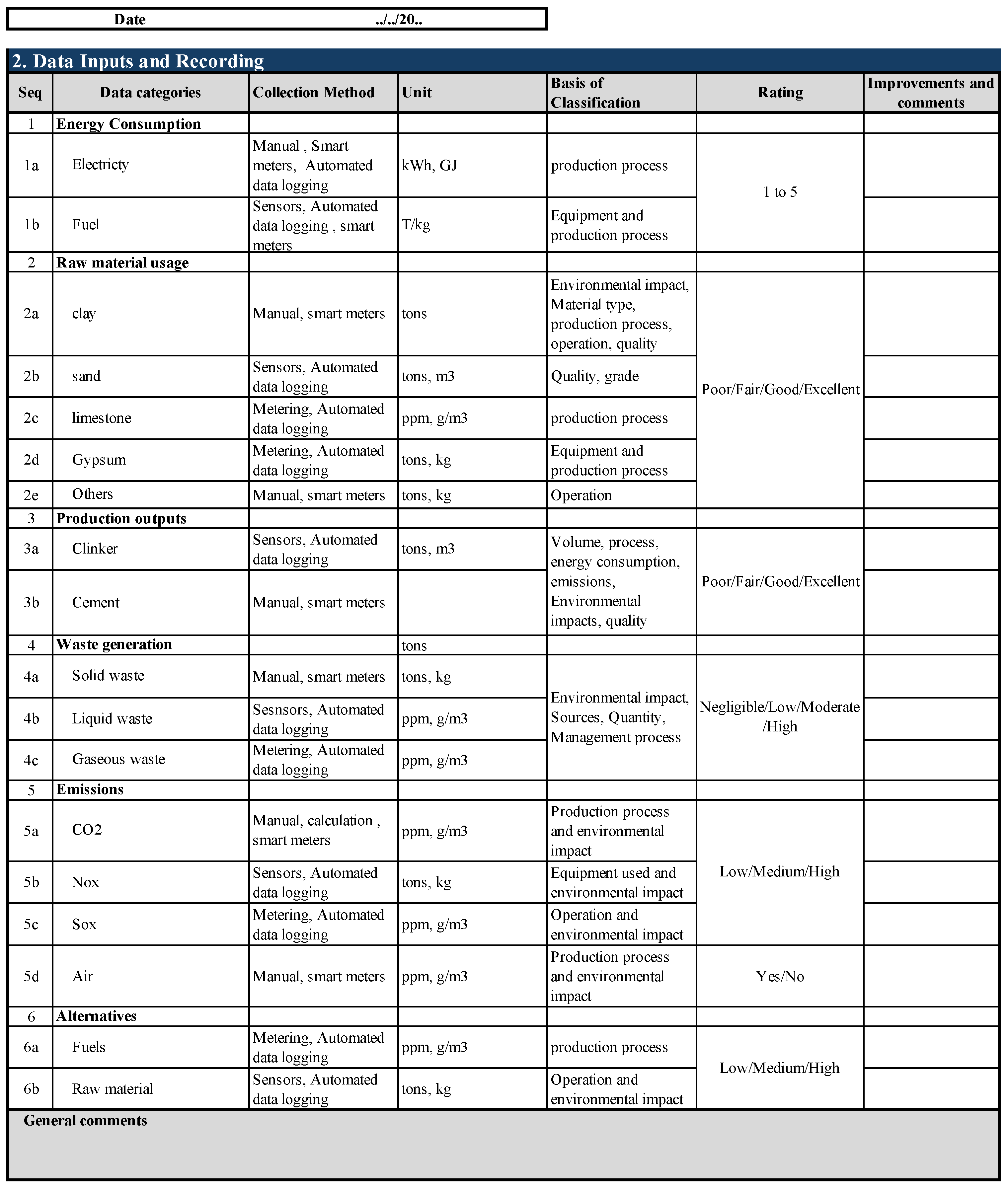
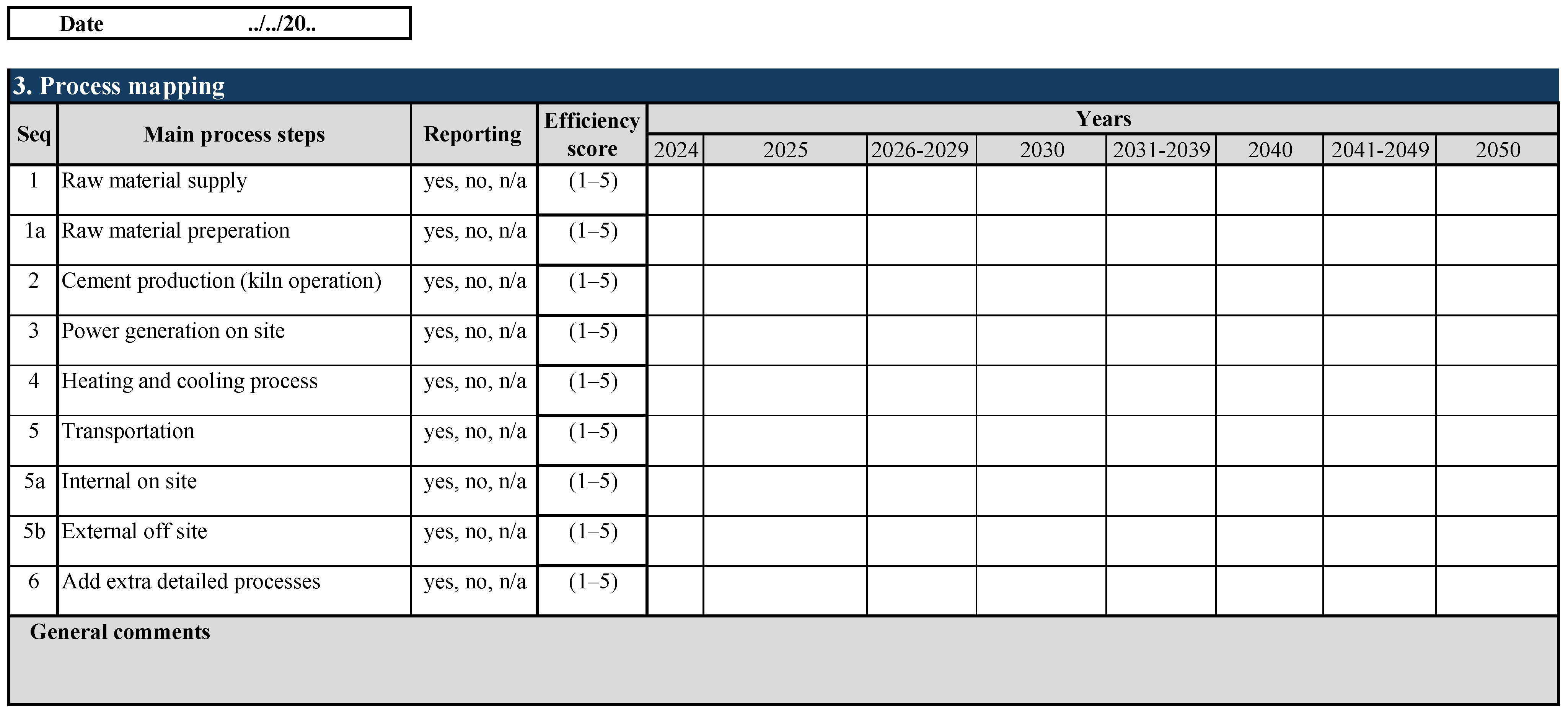
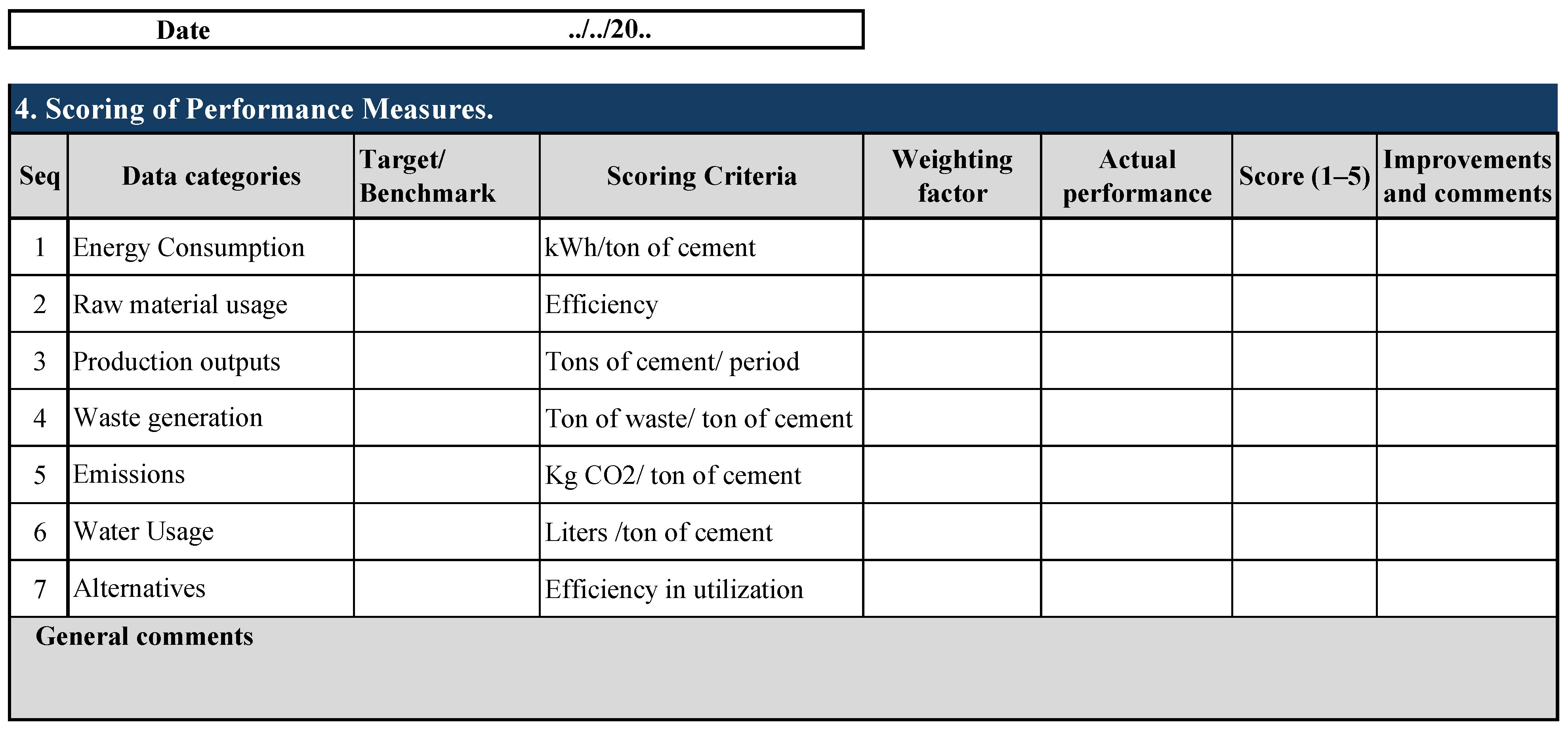
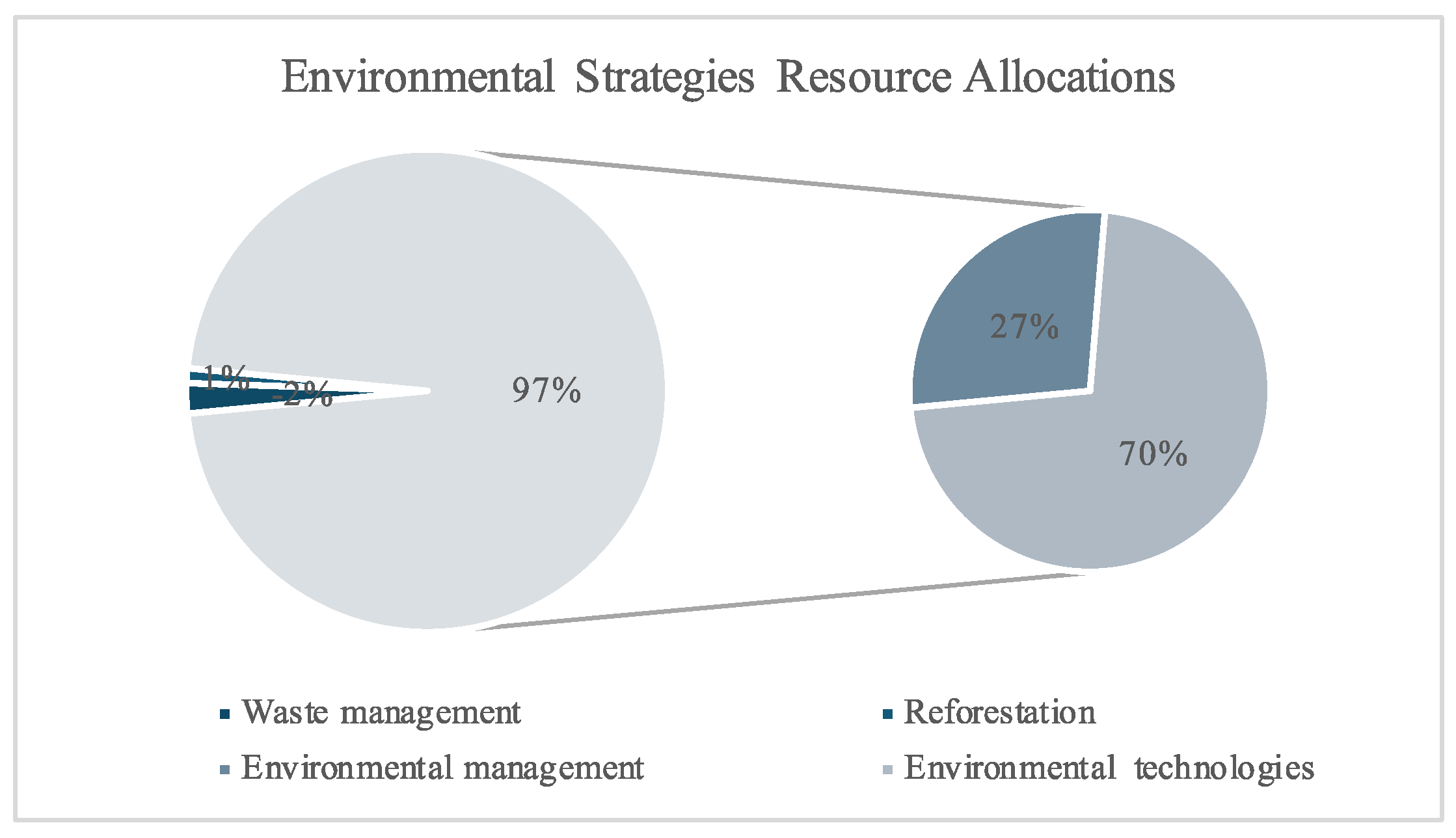

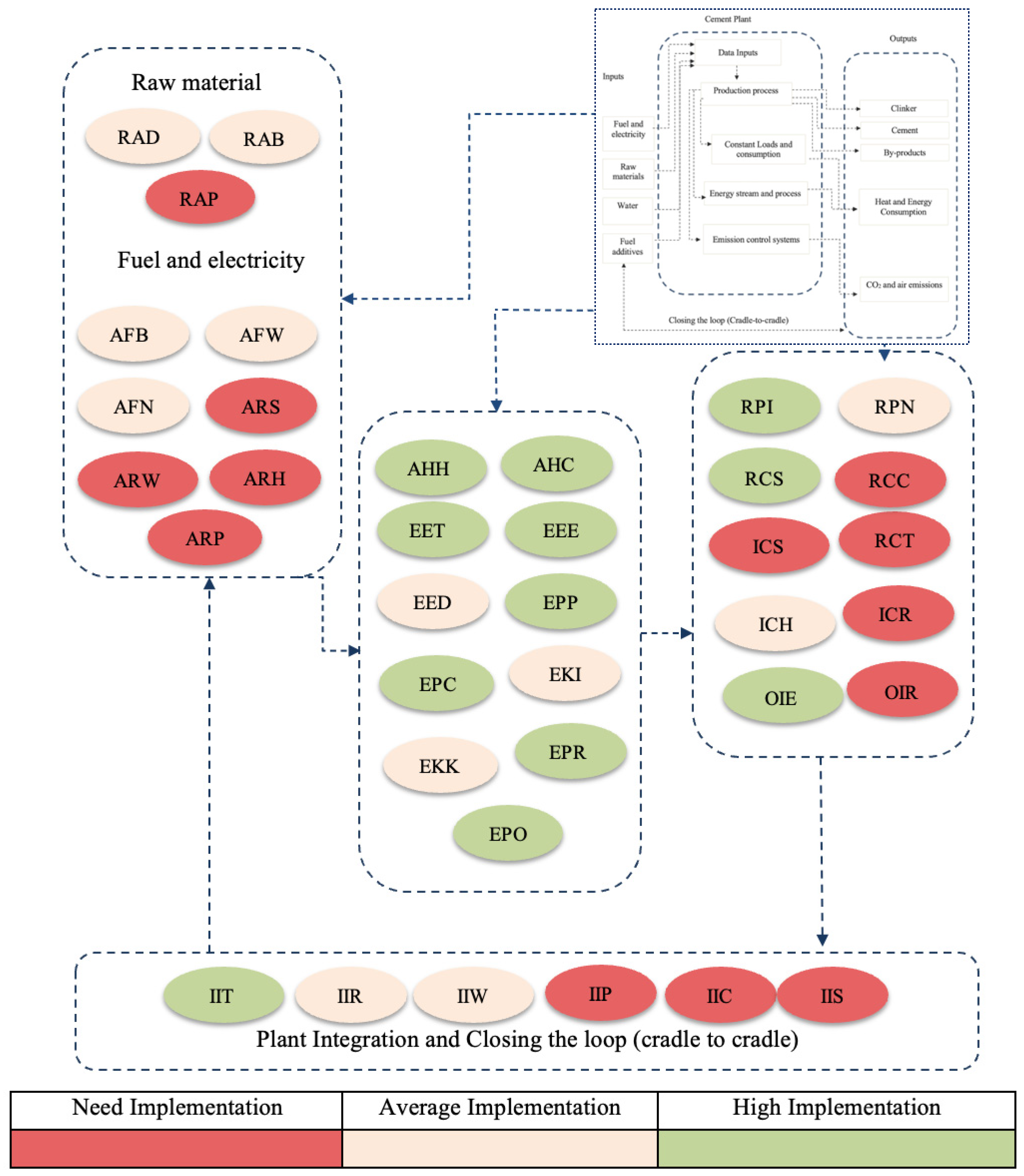


| Emission Sources | Component | Unit of Calculation | Data Source |
|---|---|---|---|
| Scope 1 | |||
| CO2 from Calcination | Clinker produced | Tons | Plant measured |
| Dust calcination | Tons | Plant measured, reports | |
| CKD emission | g/t clinker | Plant measured | |
| CO2 from fuel combustion | NCV | GJ/t fuel | Plant measured |
| EF | kg CO2/GJfu | Calculated or default IPCC/CSI | |
| Fuel consumption | Tons | Calculated, plant, reports | |
| CO2 from mobile sources | EF | kg CO2/km | Calculated or default |
| Fuel consumption | Liters | Calculated or plant | |
| Scope 2 | |||
| CO2 from external sources | Power Consumption | kWh | Plant level or reports |
| EF | gCO2/kWh | ||
| CO2 Reduction Potential | Impact Level | Estimated % of Reduction |
|---|---|---|
| The measures cannot reduce CO2 emissions from the major sources but can significantly reduce CO2 emissions from at least one source. | low | <20% |
| The measures can effectively reduce CO2 emissions from at least one source. | Medium | 20% to 50% |
| The measures can effectively improve CO2 emissions from one or more sources. | High | >20% |
| Category | Abb. | Sub-Category | Abb. | |
|---|---|---|---|---|
| 1. Process and technology efficiency | ||||
| E | Energy efficiency | EE | Electrical efficiency | EEE |
| Thermal efficiency | EET | |||
| Variable speed drives | EED | |||
| Process efficiency | EP | Process control systems | EPC | |
| Operational efficiency | EPO | |||
| Recycle and reuse | EPR | |||
| Pollution control and prevention | EPP | |||
| Kiln technology upgrade | EK | Kiln drive improvements | EKK | |
| Insulation improvements | EKI | |||
| 2. Alternative fuels and energy management | ||||
| A | Alternative fuels | AF | Biomass | AFB |
| Waste materials | AFW | |||
| Non-traditional fuels | AFN | |||
| Renewable energy | AR | Solar energy | ARS | |
| Wind energy | ARW | |||
| Hydropower | ARH | |||
| Hybrid solar panels | ARP | |||
| Waste heat recovery | AH | Heat exchanger | AHH | |
| Combined heat and power | AHC | |||
| 3. Alternative raw material and clinker production | ||||
| R | Alternative raw materials | RA | Decoronated feedstocks | RAD |
| Blending raw materials | RAB | |||
| Preprocessing of materials | RAP | |||
| Clinker substitution | RC | Calcareous oil shale | RCC | |
| Supplementary materials | RCS | |||
| Low-temperature clinkers | RCT | |||
| Product development | RP | Blended cement | RPI | |
| New product technologies | RPN | |||
| 4. Emission control and industry innovations | ||||
| I | CO2 and heat control | IC | Carbon capture and storage | ICS |
| Selective non-catalytic reduction (SNCR) systems and CRS | ICR | |||
| Synergistic heating | ICH | |||
| Innovative technology and integration | II | Advanced process technologies | IIT | |
| Developing CO2 reduction innovations | IIR | |||
| Waste treatment integration | IIW | |||
| Power plant integration | IIP | |||
| Power plant/cement plant carbonate looping | IIC | |||
| Syngas co-production | IIS | |||
| 5. Facility operations | ||||
| O | Best practices in operation | OB | Staff training and public relations | OBT |
| Maintenance and program enhancing | OBM | |||
| Water management | OBW | |||
| Standards and compliance | OS | Regulatory compliance | OSR | |
| Sustainable material standards | OSS | |||
| Environmental impact assessment | OSE | |||
| Breakthrough innovations | OI | Research and CO2 reduction innovations | OIR | |
| Environmental strategies | OIE | |||
| Poor | Low | Average | On Track | Optimal |
|---|---|---|---|---|
| Sensitivity Level | Maturity Level | Description |
|---|---|---|
| Low | High | The technology is well established and not easily affected by external factors. |
| Medium | Medium | The technology is emerging and involves moderate complexity on external factors. May have moderate sensitivity to external factors. |
| High | Low | The technology is in the early development stages. It is affected by technological complexity and is sensitive to external factors and conditions. |
| Economic Viability | Business Approach Complexity | Description |
|---|---|---|
| High | Low | The implementation of each measure offers significant cost savings and can easily be integrated with the existing plant processes. |
| Medium | Medium | The implementation of each measure offers moderate cost savings and requires organizational adaption. It can be integrated with the existing plant processes but needs planning and coordination. |
| Low | High | The implementation of each measure offers limited cost savings and high risk. It requires substantial external support to be integrated with the plant processes. |
| Level | Feasibility Percentage | Description |
|---|---|---|
| Low | <50% | The proposed mitigation measure is not feasible given the current site conditions and constraints. Lack of infrastructure and resources. Significant obstacles in the environment. |
| Medium | 50–75% | The proposed mitigation measure could be implemented given the current site conditions and constraints. Infrastructure and resources need to be modified. Moderate obstacles in the environment. |
| High | >75% | The proposed mitigation measure is feasible and well suited given the current site conditions and constraints. Infrastructure and resources are well aligned. Environmental conditions are aligned and support the implementation. |
| Level | Description |
|---|---|
| Low | The measure is not being implemented, and/or no similar measures are currently in practice. Existing measures are ineffective and/or implemented poorly. Significant room for improvement. The know-how is not available at the plant level. |
| Medium | The measure is being implemented, and/or some similar measures are currently in practice but with variable effectiveness. Existing measures are implemented but are inconsistent or lacking in some areas. Moderate room for improvement. The know-how is relatively available at the plant level. |
| High | The measure is implemented, and/or many similar measures are currently in practice. Existing measures are effective and implemented substantially and consistently. Strong foundation for improvements. The know-how is available at the plant level. |
| Performance Measures | Units | 2023 | Estimated | ||
|---|---|---|---|---|---|
| 2025 | 2030 | %/yr | |||
| OPC Production | Mton | 1.04 | 0.9 | 0.5 | (11) |
| Clinker–cement ratio | % | 78.8 | 71.41 | 54.3 | (4.8) |
| Thermal energy | TJ | 9756 | 9198.3 | 7939.7 | (2.9) |
| Electrical energy | TJ | 1235 | 1194.8 | 1100 | (1.63) |
| Natural raw material | MM tons | 4.4 | 4.02 | 3.21 | (4.42) |
| Alternative raw material | % | 6.4 | 12.26 | 52.51 | 38.42 |
| Substitution fuel | % | 19.2 | 29.12 | 81.67 | 23.2 |
| Alternative fuel consumption | ton | 118 | 127.4 | 154.4 | 57.33 |
| Water consumption | MM3 | 0.66 | 0.545 | 0.34 | (9.13) |
| Scope 1 emissions | Kg/t | 647.6 | 612.2 | 529.4 | (2.78) |
| Scope 2 emissions | Mtons | 0.16 | 0.1471 | 0.1196 | (4.12) |
| Scope 3 emissions | Kg/t | 83 | 79.6 | 72.1 | (2.05) |
| Green products | %cem | 13.0 | 36.8 | 238.8 | 68.17 |
| Dust emissions | g/t Clinker | 59.9 | 79 | 150.9 | 14.88 |
| NOx emissions | 1255 | 1249.5 | 1167.7 | (0.3) | |
| Recycled waste | tons | 20.7 | 27.8 | 61.1 | 16 |
| RDF | % heat | 10.5 | 13.1 | 24.1 | 11.7 |
| Total CO2 emissions | Mt | 2.1 | 2.07 | 1.99 | (0.72) |
| Abb. | Performance Measure | Evaluation Points | ||||||
|---|---|---|---|---|---|---|---|---|
| Industry Generic Analysis | Plants Comparison to Apply These Measures | |||||||
| Technology Maturity and Sensitivity | Economic Viability | Technology Applicability | Site Constraints | Organizational Position | Organizational Readiness and Allocations | CO2 Reduction Potential | ||
| EEE | Electrical efficiency | 5 | 1 | 4 | 3 | 4 | 4 | 3 |
| EET | Thermal efficiency | 5 | 1 | 4 | 3 | 4 | 4 | 3 |
| EED | Variable speed drives | 3 | 3 | 5 | 3 | 3 | 3 | 3 |
| EPC | Process control systems | 3 | 2 | 3 | 4 | 4 | 4 | 4 |
| EPO | Operational efficiency | 4 | 3 | 4 | 4 | 4 | 3 | 4 |
| EPR | Recycle and reuse | 5 | 1 | 4 | 5 | 5 | 5 | 3 |
| EPP | Pollution control and prevention | 5 | 1 | 5 | 5 | 5 | 4 | 4 |
| EKK | Kiln drive improvements | 4 | 4 | 5 | 3 | 3 | 3 | 4 |
| EKI | Insulation improvements | 3 | 3 | 5 | 5 | 3 | 4 | 3 |
| AF | Alternative Fuels | 3 | 3 | 5 | 5 | 3 | 4 | 3 |
| AFB | Biomass | |||||||
| AFW | Waste materials | |||||||
| AFN | Non-traditional fuels | |||||||
| AR | Renewable Energy | 3 | 3 | 5 | 5 | 3 | 4 | 4 |
| ARS | Solar energy | |||||||
| ARW | Wind energy | |||||||
| ARH | Hydropower | |||||||
| ARP | Hybrid solar panels (PVT) | 3 | 4 | 4 | 5 | 1 | 2 | 4 |
| AH | Waste heat recovery | 5 | 5 | 5 | 2 | 5 | 5 | 4 |
| AHH | Heat exchanger | |||||||
| AHC | Combined heat and power | |||||||
| RAD | Decarbonated feedstock | 3 | 3 | 4 | 3 | 3 | 3 | 4 |
| RAB | Blending raw materials | 5 | 3 | 4 | 3 | 3 | 3 | 3 |
| RAP | Preprocessing of materials | 2 | 3 | 3 | 4 | 2 | 3 | 3 |
| RCC | Calcareous oil shale | 1 | 2 | 3 | 5 | 3 | 1 | 5 |
| RCS | Supplementary materials | 3 | 3 | 4 | 4 | 4 | 5 | 5 |
| RCT | Low-temperature clinker | 1 | 1 | 1 | 4 | 3 | 1 | 4 |
| RPI | Blended cement | 5 | 5 | 5 | 1 | 3 | 4 | 5 |
| RPN | New product technologies | 1 | 3 | 3 | 5 | 3 | 4 | 5 |
| ICS | Carbon capture and storage | 1 | 5 | 1 | 1 | 2 | 2 | 4 |
| ICR | Catalytic reduction systems (CSR) and SNCR | 4 | 4 | 4 | 3 | 3 | 4 | 5 |
| ICH | Synergistic heating | 4 | 4 | 4 | 3 | 3 | 4 | 3 |
| IIT | Advanced process technologies | 4 | 4 | 4 | 3 | 4 | 4 | 5 |
| IIR | Developing CO2 reduction innovations | 3 | 3 | 3 | 3 | 3 | 3 | 5 |
| IIW | Waste treatment integration | 4 | 3 | 4 | 3 | 3 | 4 | 4 |
| IIP | Power plant integration | 4 | 4 | 4 | 3 | 3 | 4 | 5 |
| IIC | Power plant/cement plant carbonated loop | 1 | 2 | 2 | 5 | 1 | 1 | 5 |
| IIS | Syngas co-production | 1 | 3 | 3 | 5 | 1 | 1 | 5 |
| O * | Facility operations | |||||||
| Main Areas | First Subarea | Score A | Score B | Abb. | Second Subarea | Score A | Score B |
|---|---|---|---|---|---|---|---|
| Process and technology efficiency | Energy efficiency | 3.35 | 4.18 | EEE | Electrical efficiency | 3.04 | 4.13 |
| EET | Thermal efficiency | 3.83 | 4.45 | ||||
| EED | Variable speed drives | 3 | 3.75 | ||||
| Process efficiency | 3.72 | 3.93 | EPC | Process control systems | 3.5 | 3.83 | |
| EPO | Operational efficiency | 4.06 | 4.06 | ||||
| EPR | Recycle and reuse | 3.27 | 3.75 | ||||
| EPP | Pollution control and prevention | 4.13 | 4.13 | ||||
| Kiln technology upgrade | 3.28 | 3.63 | EKK | Kiln drive improvements | 2.81 | 3.44 | |
| EKI | Insulation improvements | 3.85 | 3.85 | ||||
| Alternative raw material and clinker production | Alternative raw materials | 3.40 | 3.65 | RAD | Decarbonated feedstocks | 3.3 | 3.86 |
| RAB | Blending raw materials | 3.33 | 3.23 | ||||
| RAP | Preprocessing of materials | 3.75 | 3.75 | ||||
| Clinker substitution | 3.50 | 3.12 | RCC | Calcareous oil shale | 1.25 | 1.25 | |
| RCS | Supplementary materials | 3.75 | 3.06 | ||||
| RCT | Low-temperature clinkers | 3.75 | 3.75 | ||||
| Product development | 4.37 | 4.22 | RPI | Blended cement | 4.53 | 4.53 | |
| RPN | New product technologies | 4.13 | 3.75 | ||||
| Alternative fuels and energy management | Alternative fuels | 3.31 | 3.66 | AFB | Biomass | 2.95 | 3.39 |
| AFW | Waste materials | 2.98 | 3.37 | ||||
| AFN | Non-traditional fuels | 4.33 | 4.50 | ||||
| Renewable energy | 1.96 | 2.81 | ARS | Solar energy | 1.25 | 3.75 | |
| ARW | Wind energy | 1.88 | 3.13 | ||||
| ARH | Hydropower | 3.21 | 2.50 | ||||
| ARP | Hybrid solar Panels (PVT) | 1.88 | 1.25 | ||||
| Waste heat recovery | 3.75 | 4.01 | AHH | Heat exchanger | 3.75 | 3.75 | |
| AHC | Combined heat and power | 3.75 | 4.27 | ||||
| Emission control and industry innovations | CO2 and heat control | 2.50 | 2.88 | ICS | Carbon capture and storage | 1.25 | 2.50 |
| ICR | Selective non-catalytic reduction systems (SNCR) and CRS | 3.75 | 3.33 | ||||
| ICH | Synergistic heating | 3.75 | 3.13 | ||||
| Innovative technology and integration | 2.75 | 3.26 | IIT | Advanced process technologies | 5 | 5 | |
| IIR | Developing CO2 reduction innovations | 3.75 | 4.20 | ||||
| IIW | Waste treatment integration | 3.75 | 4.58 | ||||
| IIP | Power plant integration | 1.25 | 2.03 | ||||
| IIC | Power plant/cement plant carbonate looping | 0.38 | 0.77 | ||||
| IIS | Syngas co-production | 1.25 | 1.25 | ||||
| Facility operations | Best practices in operation | 4.17 | 4.36 | OBT | Staff training and public relations | 4.17 | 4.45 |
| OBM | Maintenance and program enhancing | 3.75 | 3.75 | ||||
| OBW | Water management | 4.64 | 5 | ||||
| Standards and compliance | 3.80 | 4.41 | OSR | Regulatory compliance | 3.75 | 5 | |
| OSS | Sustainable material standards | 4.38 | 4.37 | ||||
| OSE | Environmental impact assessment | 3.19 | 3.75 | ||||
| Breakthrough innovations | 4.50 | 4.50 | OIR | Research and CO2 reduction innovations | 5 | 5 | |
| OIE | Environmental strategies | 3.75 | 3.75 |
Disclaimer/Publisher’s Note: The statements, opinions and data contained in all publications are solely those of the individual author(s) and contributor(s) and not of MDPI and/or the editor(s). MDPI and/or the editor(s) disclaim responsibility for any injury to people or property resulting from any ideas, methods, instructions or products referred to in the content. |
© 2025 by the authors. Licensee MDPI, Basel, Switzerland. This article is an open access article distributed under the terms and conditions of the Creative Commons Attribution (CC BY) license (https://creativecommons.org/licenses/by/4.0/).
Share and Cite
Khalil, E.; AbouZeid, M. Framework for Cement Plants Assessment Through Cement Production Improvement Measures for Reduction of CO2 Emissions Towards Net Zero Emissions. Constr. Mater. 2025, 5, 20. https://doi.org/10.3390/constrmater5020020
Khalil E, AbouZeid M. Framework for Cement Plants Assessment Through Cement Production Improvement Measures for Reduction of CO2 Emissions Towards Net Zero Emissions. Construction Materials. 2025; 5(2):20. https://doi.org/10.3390/constrmater5020020
Chicago/Turabian StyleKhalil, Esraa, and Mohamed AbouZeid. 2025. "Framework for Cement Plants Assessment Through Cement Production Improvement Measures for Reduction of CO2 Emissions Towards Net Zero Emissions" Construction Materials 5, no. 2: 20. https://doi.org/10.3390/constrmater5020020
APA StyleKhalil, E., & AbouZeid, M. (2025). Framework for Cement Plants Assessment Through Cement Production Improvement Measures for Reduction of CO2 Emissions Towards Net Zero Emissions. Construction Materials, 5(2), 20. https://doi.org/10.3390/constrmater5020020




